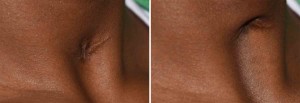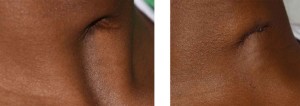Background: A tracheostomy is a life-saving airway procedure. Done from infancy to seniors it is the introduction of a breathing tube through the midline neck skin into airway to bypass whatever obstruction lies above it. The breathing may be left in a matter of days dependent on the medical condition it is treating. When it is removed, the open neck wound is left to heal in on its own.
While most tracheostomy scars will heal, the process of secondary intentional healing often leaves a wide scar which may have some degree of depression. The longer the breathing tube was left in place usually make for more of a depressed tracheostomy scar. This is due to the tissue loss between the skin and the trachea which has occurred due to compression and fat atrophy.
In some depressed tracheostomy scars, a very visible retraction of the neck skin is seen when swallowing. This is due to tethering of the overlying scarred and shortened neck tissues to the trachea. The trachea is moved upward due to contraction of the muscles at the base of the tongue. The skin edges of the tracheostomy scar can be seen to pull upward and into the depressed scar area as swallowing occurs.



While excising the neck scar and closing the skin over it seems like it would be a good scar treatment, it often is not. The very depressed trach scar is really missing subcutaneous tissue. An autologous dermal-fat graft is needed to replace what had been lost previously to both eliminate the depression and reduce the degree of tracheal retraction that is seen.
Highlights:
1) Depressed tracheostomy scars that retract on swallowing have a severe shortage of tissue.
2) To eliminate the soft tissue depression and decrease the visible tracheostomy scar retraction, a tissue graft is needed to fill in the space after scar excision and release.
3) The best tissue graft for any depressed scar is a dermal-fat graft.
Dr. Barry Eppley
Indianapolis, Indiana




